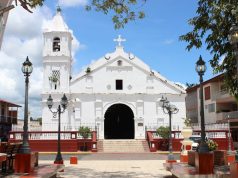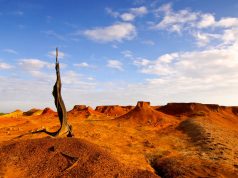Los Santos and Herrera provinces offer a long list of cultural festivities and natural places
Citizens of that region proudly refer to the Azuero Peninsula as the “heart” of the country. A perfect nickname considering that this sector supports the tradition, agriculture and even the merriment and fun of an entire nation.
Azuero has a very rich history that dates back to indigenous groups of the Pre-Columbian era, as well as an almost intact Spanish culture, which is best appreciated in the festivals with colonial vestiges that predominate in the region.
Festivities
The Azuero Peninsula has developed a large part of its economy around the festivities that are celebrated there. During the year there are all kinds of events and celebrations, so many that it is recommended to return for several years to go to each one. Here are some of the most important ones.
Las Tablas Carnival
This small city is the capital of the Los Santos province. It is internationally known as the epicenter of the celebration of carnivals in Panama, which take place every year between the months of February and March. For four days the queens of the “Las Tablas Carnival” wear luxurious and eye-catching outfits. They parade in their floats, made by Panamanian artisans, and cross the streets surrounding the town’s central park several times. The classic rivalry of Calle Arriba and Calle Abajo with their creative and controversial takes, is a tradition that has spread throughout the country’s carnivals.
In Azuero, towns like Chitre, Pedasi, Los Santos and Ocu, celebrate their carnivals with almost the same excitement as in Las Tablas, perhaps not with such luxury, but with the same human warmth that attracts both local and foreign visitors.
Holy Week
When it comes to religious traditions, Holy Week is a very important holiday. It is the moment when the Passion, Death and Resurrection of Jesus Christ are commemorated. In towns of Azuero such as Parita, Chitre, Las Tablas, Guarare, interpretations of the Via Crucis and representations of the Passion of Christ in a very real way are frequent. Here the traditions are attached to the magical religious folklore, attracting thousands of people, whether believers or not, to live a cultural, religious or spiritual experience.
Azuero International Fair
This fair offers all its visitors a large number of activities for young and old for 58 years. Visitors enjoy agricultural, livestock, artisanal, industrial, folkloric, gastronomic exhibitions and mechanical games, with more than 700 exhibitors, a number that is increasing.
Likewise, a large number of equine, bovine and canine competitions are held, while still giving importance to the stage of shows where national artists delight thousands of people with their music, dance and talent. This fair attracts more than 250,000 people for 11 days, it is the fair with which the summer fair season closes.
This year it only made a ribbon cutting – in virtual mode – to symbolically inaugurate this event, with the hope of being able to do it in person in 2022, as expressed by the Board of Trustees of the Azuero International Fair (FIA).
Corpus Christi
It is another of the great religious celebrations of Azuero with influences from Spanish traditions, which are celebrated in a special way. Colored carpets made with sawdust, flowers, or rice husks are made, where the Diablicos perform their dance symbolizing the syncretism of Panamanian culture: the pagan and the religious.
Theatrical demonstrations are held since colonial times in order for the indigenous people to accept Christian religious teachings. The Dance of the Great Devil is a fight between good and evil, to see who manages to keep the soul of a certain person. The dances and costumes are similar to those used today in Spain during Corpus Christi.



Museums
Azuero has a lot of history and cultural roots that can be heard among its inhabitants. Its museums make clear the spirit of a region that empathically connects with anyone, no matter where they come from.
Herrera Museum
It was built by a colonel in 1917, and was later converted into a post office. In the 1950s, it was thought about how a place should be to present the different samples of history and memorabilia that some inhabitants had, so this place was chosen as a museum. It has a two-story structure, and five rooms with different reviews of both prehistoric objects and artifacts that have been evolving for decades.
Nationality Museum
It was inaugurated on November 10, 1974 in Los Santos. It is a colonial building that was probably built in the 18th century. It is known as the House of the Cabildo, because in it the session was held where the “First Shout of Independence” of Panama from Spain was proclaimed, on November 10, 1821.
The museum has five rooms: Pre-Columbian Art, Gesta de la Conquista and La Gesta Independencia, Cabildo or First Council room, Colonial Religious Art and Typical Cuisine. They exhibit pieces from the Cerro Juan Diaz archaeological site, as well as documents related to the Villa’s cry, such as weapons, furniture, notarial books, paintings, wood carvings and silverware.
Manuel Fernando Zarate Museum
It was inaugurated on September 24, 1969 as a result of the death of Professor Manuel F. Zarate, an illustrious Guarareño dedicated to folklore. It is built on a board of mud with a style of housing property of the region “casa de quincha” with a portal around it. It is divided into two rooms: one dedicated to the La Mejorana Festival, it has a gallery of queens and exhibits different types of skirts as well as clothing for different dances; the second is dedicated to the memory of Professor Zarate, where they display samples of titles and decorations belonging to the professor.
Belisario Porras Museum
Inaugurated on November 28, 1956 in commemoration of his birth, the facilities were owned by his maternal grandparents, Don Joaquin de Barahona Espino and his wife Doña Francisca de Leon Moscoso. In addition, it was the house where Dr. Porras was born.
It is a single room of history shows the life and work of the one who was three times president of the Republic of Panama. Inside there is a portrait made in oil by the painter Juan Manuel Cedeño in 1959, his presidential sash, military dress, photographs that highlight the works made by the Santeño leader throughout his tenure, as well as objects such as books, diplomas, medals, and others.
Best Beaches of Azuero
If there is something that you love about this beautiful province, it is the number of beaches that can be found near picturesque towns, here are some to visit.
Venao Beach
It is very famous among those who practice “surfing”, it is also a perfect place to relax with incredible sunrises. It is one hour from the town of Pedasi. You can find hotels and hostels in Pedasi or Venao. It is a tourist beach area, where you can also see turtles spawning, watch whales, go diving and fishing or go on an excursion to Isla Iguana.
Las Comadres Beach
It is located 7 km from Las Tablas. The name of the beach is due to a legend about two friends that were “comadres”, who fought for a Man and turned into rocks, shapes that can be seen from the shore. Here you can find several restaurants on the beach that offer delicious local dishes at a good price.
El Toro Beach
It is one of the favorites among the locals of Pedasi, because of how close it is to the town. The beach has more or less two kilometers of coastline, with little extension of sand and vegetation, so it is very important to bring an umbrella or a tent to protect yourself from ultraviolet rays.
Arenal Beach
It is also very close to the Pedasi town. Its name is due to the amount of fine white sand. Of course, it is a lonely destination. There are no shops or restaurants in the surroundings, so everything must be brought from Pedasi. Boats leave from this beach to Isla Iguana.
Los Destiladeros Beach
It is a brown sand beach, with green areas and a wide area, it is located 10 kilometers from Pedasi. Like other beaches on the Azuero Peninsula, it lacks large crowds of bathers. Little by little it is becoming one of the favorite beaches in the area. Some hotels are located on the shoreline.
Cambutal
Located in the South of the Azuero Peninsula, specifically in the district of Tonosi. For many it is a place where you can go horseback riding, walk on the beach, or simply “surf” its big waves, the latter being the most attractive activity. Nearby are seven waterfalls, natural pools, hiking trails and caves.








Things to Do
Go to yoga classes in Cambutal beach. The Sansara Surf and Yoga Resort offers yoga classes surrounded by beautiful beaches and mountains full of nature. www.sansararesort.com
Take a boat to Isla Iguana and enjoy a “day trip.” A natural reserve only 20 minutes from Pedasi, where you can enjoy coral reefs, multicolored fish and paradisiacal beaches. Boats leave from Playa El Arenal and It has a cost between $ 20.00 and $ 25.00 per person.
Learn all about typical food of the region in a classic fonda, restaurants run by Panamanian families that offer culinary delights at a cost starting $ 3.50. They are found throughout the region.
Visit Chitre Cathedral, a place of impressive architecture and more than 100 years of history. Located in the heart of Chitre Town, is an ideal place to take photos of its impressive frescoes, large paintings and beautiful altar. Entrance is free. For schedules and more information: catedralchitre@gmail.com.
Relax watching the arrival of hundreds of sea turtles to Isla Cañas. This wildlife refuge is the most important turtle nesting site on the Pacific Coast. This magic of Mother Nature happens between the months of July and November. Information on “tours”: info@cubitatours.com.













